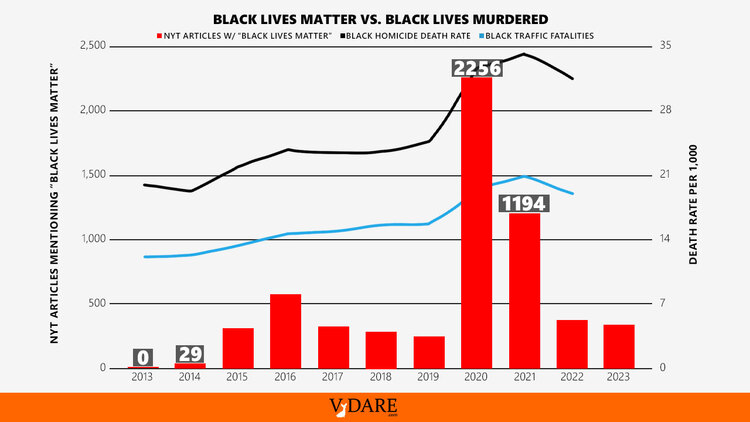
"Black Lives Matter" In the NYT And Black Lives Murdered Everywhere
By Steve Sailer
02/10/2024


The first time The New York Times ever mentioned the phrase “Black Lives Matter” in its history going back to 1851 was August 21, 2014, twelve days after Michael Brown’s death at Ferguson, MO. Since then, it has run 5,915 more articles with the phrase “Black Lives Matter.”
As you can see, there were two eras in which Black Lives Matter was ascendant: 2015-2016 (the Ferguson Effect), after which Soros and other smart money funders let it slowly fizzle, followed by the utter insanity of 2020-21 (the Floyd Effect), after which, I’m guessing, the Biden White House got the word through to the NYT than it was no longer in the Democratic Party’s electoral best interests to continue harping on BLM.
This is not to say that most murders or car crashes are the fault of the NYT subscribers, but that the NYT, being hugely influential on the rest of the news media, is the best single metric for evaluating Establishment dictates, which the police respond to.
For reasons utterly baffling to the New York Times, this barrage of concern for black lives led to a big boost in black deaths in BLM Era I and then a huge boost in black deaths in BLM Era II. It’s almost as if the cops got the message that the Establishment didn’t want them to hassle as many black drivers for driving badly, so they didn’t. In turn, blacks drove worse, died more in car crashes, and carried more illegal handguns when they went out, which led to more blacks shooting more blacks.
In case you are wondering what Data Science magic I’m using to scrape these numbers, just go to nytimes.com and click on the magnifying glass in the upper left corner, then specify “Black Lives Matter” and a date range.
Boring methodological note: If you are interested in replicating this data, be aware that there is minor methodological issue that drives up the death rates a few percentage points between 2017 and 2018 in the CDC’s WONDER cause of death data. From 1999-2020 the CDC reported death rates for four bridged race categories and from 2018 through the present for six single rate categories. I believe the most important change was to break out “Mixed Race” as its own category. The relevant change was that death rates for blacks were a few percent higher in 2018-onward under the new system than under the old system. I chose to place the break in methodology between 2017 and 2018 because that’s less politically salient.
